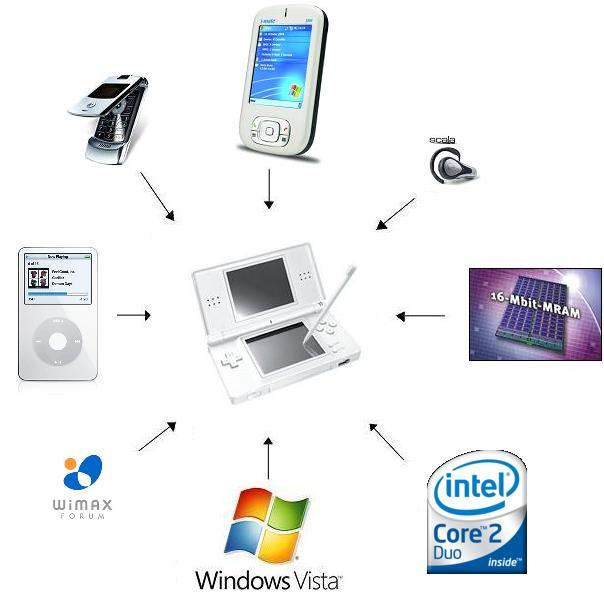This is what I think the perfect portable system would be like. Timeframe - within 5 years:
- The resolution on the iPod is much better than the Nintendo DS lite and it can play music plus video. Some high-end mobile phones have even higher resolution, close to 400 dpi. The materials costs don't change as resolution increases, it just requires a more modern manufacturing plant.
- The iPods earphones could be inserted into the Nintendo DS lites sound port. Alternatively high-end Neodynium magnet based headphones used on digital stethoscopes (which reproduce low frequency sounds particularly well) could be used.
- Instead of a GPU it will have a RPU which is 50-100 times faster. In addition, new object modelling techniques based on algebraic geometry have the potential to further increase graphics speed by a factor of 10x.
- The current iPod can store 150 hours of video on its hard drive. With Perpendicular recording it could store 1,500. More likely though the hard disk will be dropped entirely in favour of PRAM memory which is fast, high density, low power and like flash retains its state when powered off.
- WiMax has a range of 30 mile as apposed to wifi with only 300 feet. The WiMax could be used to download videos of the internet something the iPod cant do. With ubiquitous fast low latency wi-fi the effective 'disk size' is collosal. Reducing cost the device would just store keys and download on-demand.
- A built in camera would give the Nintendo DS lite the ability to be a video phone.
- Windows Vista is the latest operating system from Microsoft adding it to the Nintendo DS lite would make the Nintendo DS lite a PDA with voice recognition. One could argue though that the operating system becomes less relevant than the multimedia libraries. Google's gmail shows that the concept of directories of files and folders is not central. Future users may never need to see a directory heirarchy and could simply ask for 'That video of Madonna, once again'.
- Intels Core 2 Duo has the lowest watts per instruction ratio of any Intel CPU and it is a multicore platform. ARM processors, as used in Mobile phones and iPods have better performance per watt due to their RISC architecture. Dual ARM processors are used in iPods. Already available are ARM processors embedded in FPGA fabric (reconfigurable electronics). The FPGA design allows the same circuit area to hold different circuit logic at different times. This means that additional instructions can be added to the processor dynamically. This is particularly useful in graphics and database applications where a large amount of data is being streamed.
- The combination of Intels 45 nanometer technology and Trigate transistors technology will greatly increases clock frequencies as leakage current decreases.
- The Nintendo DS lite currently has only 4 MB of main memory. Infineon Technologies has invented a 16 MB MRAM chip that uses 99% less power than regular RAM and IBM researchers have demonstrated that MRAM can be six times faster than the industry standard's dynamic RAM (DRAM), and it is almost as fast as today's static RAM (SRAM) found in cache. In addition, 256MB PRAMs have been demonstrated, and may have a higher density lower static-current requirment than MRAM. The properties of chalcogenide materials used in PRAMs have been under very active research because of their widespread use in re-writable DVDs.
- MRAM could be used to replace the cache in the CPU reducing power consumption.
- The main memory and CPU could be combined on a single die eliminating resistance-capacitance (RC) delay.
- A MEMS based projector would be incorporated, alongside the camera.
- A 30 millimeter Blu-ray Disc player could be included opposite the on switch. Alterantively memory cards could be used with the advantages of no moving parts and easier migration to higher-density formats.
- Researchers from IBM and the Georgia Institute of Technology created a new speed record when they ran a silicon/germanium helium supercooled chip at 500 gigahertz (GHz) [1]. The chip operated above 500 GHz at 4.5 K (451 degrees below zero Fahrenheit) [2] and simulations showed that it could likely run at 1,000 GHz. At room temperature it ran at 350 GHz.[1][2]
- Instead of a lithiun ion battery it will have a rechargable Fuel cell.
Comment: The central image looks WAY too low tech. The screen should be out to the edges. With touch sensitive screen and voice activated, a separate stylus pad should go. You could have physical buttons/sliders on the edges of the box if needed.
further reading[]
Rather than wait for some anonymous engineer deep inside some big company to build exactly the mobile phone they want, the Homebrew Mobile Phone Club is taking matters into their own hands. Download their plans and make your own improvements.
- ↑ "Chilly chip shatters speed record". BBC Online. 2006-06-20. http://news.bbc.co.uk/1/hi/technology/5099584.stm. Retrieved June 24 2006.
- ↑ "Georgia Tech/IBM Announce New Chip Speed Record". Georgia Institute of Technology. 2006-06-20. http://www.gatech.edu/news-room/release.php?id=1019. Retrieved June 24 2006.

